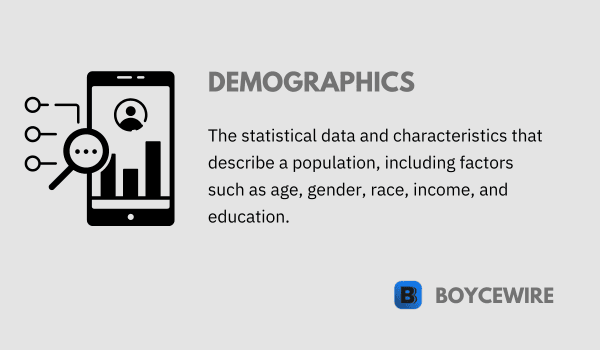Demographics: Definition, Characteristics & Examples

What are Demographics?
Demographics is a fascinating field that forms the bedrock of many social, economic, and political discourses worldwide. At its core, demographics are the statistical study of populations, especially human beings. It is a discipline that not only quantifies people, but also studies the intricate patterns of change over time and the differences among various regions and population groups. Births, deaths, migrations, aging – these are not just dry statistical facts; they offer profound insights into the societies we live in, affecting everything from policy-making to business strategy.
The word “demography” comes from the Greek words “demos,” meaning people, and “graphy,” which implies a method of measurement or description. This field emerged as a distinct area of study in the late 19th century, but the interest in populations and their studies can be traced back to antiquity. Today, demography is a multidisciplinary field, intersecting with various areas like sociology, economics, anthropology, geography, history, and public health, to name a few.
Key Points
- Demographics refer to the statistical characteristics of human populations, including age, gender, race, ethnicity, education, income, and geographic location.
- Demographic data provides insights into population size, distribution, composition, and trends, which are essential for understanding social, economic, and cultural dynamics.
- Factors such as birth rates, death rates, fertility rates, migration patterns, and aging populations are important demographic indicators.
Characteristics of Demographics
Demographics are distinguished by several key characteristics that make it an essential discipline in understanding human societies. Here are the main features that demography encompasses:
- Population Size: The most fundamental characteristic studied in demography is the size of the population. Demographers count the number of people in a particular region, country, or the entire world. The size of a population can tell us much about the resources needed, potential labor force, and the scale of market demand.
- Population Distribution: Demography also studies how populations are distributed across a geographical area. The distribution may be studied on a large scale—like the density of population in different countries—or on a smaller scale, such as the distribution of people in various regions within a country.
- Population Composition: The composition of a population refers to the characteristics of the individuals who make up the population. This can include age, sex, marital status, education, occupation, ethnicity, and religion. These characteristics are vital in understanding the social structure of a population.
- Population Dynamics: This involves studying the changes in population size and composition over time and the factors driving these changes. The main components of population dynamics include fertility (births), mortality (deaths), and migration.
- Statistical Study: Demography relies heavily on statistical methods to collect, analyze, and interpret data related to population. This includes the use of surveys, censuses, and various statistical models.
- Interdisciplinary Approach: Demography is an interdisciplinary field. It applies theories and methods from various disciplines like economics, sociology, geography, anthropology, and statistics to understand the complex dynamics of population changes.
List of Demographics
- Age: This is one of the most fundamental demographic characteristics. It is typically divided into groups or “cohorts,” such as children (0-14), working age adults (15-64), and elderly (65 and above).
- Gender: Another primary demographic characteristic is gender. Understanding the gender balance of a population can help illuminate social dynamics, health outcomes, and economic opportunities.
- Race and Ethnicity: These demographics can reveal cultural, historical, and social patterns within a population. They are often used in studies of social inequality and diversity.
- Income: Income levels are important in economic demographics. They can show the economic health of a population, levels of inequality, and potential market size.
- Education: Educational attainment is a key demographic characteristic. It can indicate the skill level of a population, economic potential, and social mobility.
- Occupation: The types of jobs people have can tell us much about the economic structure of a region and the living standards of its inhabitants.
- Marital Status: This can include categories like single, married, divorced, or widowed. Marital status can influence housing needs, economic status, and health outcomes.
- Family Size and Structure: This includes the number of children in a family, the number of adults, and the relationships between them (e.g., single-parent families, nuclear families, extended families).
- Geographic Location: Where people live — whether it’s urban or rural, coastal or inland, in a particular region or country — is another important demographic factor.
- Religion: Religious affiliation can be a significant factor influencing culture, social norms, and political views.
- Health Status: This can cover a wide range of factors, including disability status, chronic illnesses, mental health, and general well-being.
Understanding these demographics can provide a detailed snapshot of a population at a particular point in time and help predict future trends.
Examples of Demographics
1. Population Census
A population census is the most comprehensive example of demography. Countries conduct a census every few years to collect detailed data about their population, such as age, sex, marital status, income, occupation, etc. This data is used for planning, policy-making, and research.
2. Market Research
Companies often use demographic data to understand their target market better. For instance, a cosmetic company may focus on women aged 18-35, or a toy manufacturer might target children aged 3-8 and their parents.
3. Urban Planning
City planners use demographic data to anticipate the future needs of a city’s population. For instance, if a city has a large and growing population of elderly residents, the city may need more healthcare facilities, accessible housing, and public transportation options.
4. Healthcare
Demographic data is crucial for healthcare planning and research. For example, understanding the age distribution of a population can help predict the demand for healthcare services. Similarly, data on income and education can help identify health inequalities.
5. Education
School districts use demographic data to plan for the future. If there’s a high birth rate in an area, they may need to build more schools or expand existing ones to accommodate the rising number of students.
6. Political Campaigns
Politicians use demographic data to understand their constituents’ needs and priorities better. They can also use this information to target their campaign messaging to specific demographic groups.
7. Social Research
Sociologists, anthropologists, and other social scientists use demographic data to study social phenomena, such as migration patterns, racial inequality, or the impact of education on income levels.
8. Environmental Studies
Demographers study population trends and their impact on the environment. For instance, they might study how urbanization is affecting deforestation or how population growth is impacting water resources.
FAQs
Demographics refer to the statistical characteristics of human populations, including factors such as age, gender, race, ethnicity, education, income, and geographic location.
Demographics provide valuable insights into the composition and trends of populations, which have significant implications for various aspects of society, such as public policy, business marketing strategies, resource allocation, and social services planning.
Demographic data is collected through various methods, including national censuses, surveys, administrative records, and sampling techniques. These data sources help gather information about population size, distribution, and characteristics.
Demographics can provide information on birth rates, death rates, fertility rates, and migration patterns, allowing us to understand population growth or decline and its potential implications for areas such as workforce dynamics, economic development, and social changes.
About Paul
Paul Boyce is an economics editor with over 10 years experience in the industry. Currently working as a consultant within the financial services sector, Paul is the CEO and chief editor of BoyceWire. He has written publications for FEE, the Mises Institute, and many others.

Further Reading
 Absolute Advantage: Definition & Example - When a nation is more efficient making a good over another, it has an absolute advantage.
Absolute Advantage: Definition & Example - When a nation is more efficient making a good over another, it has an absolute advantage.  Nash Equilibrium: Definition, Limitations & Example - Nash equilibrium refers to the situation whereby a group of individuals choose the most optimal strategy and do not deviate…
Nash Equilibrium: Definition, Limitations & Example - Nash equilibrium refers to the situation whereby a group of individuals choose the most optimal strategy and do not deviate…  Contra Account - A contra account is a type of account that is used to offset or reduce the balance of another related…
Contra Account - A contra account is a type of account that is used to offset or reduce the balance of another related… 